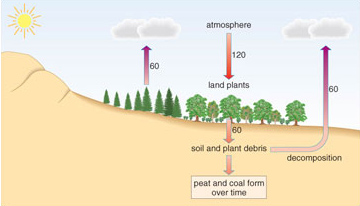4.2 The terrestrial carbon cycle
Figure 1.10 shows the rates of natural carbon exchange between the terrestrial system and the atmosphere.

Question 9
Using the data in Figure 1.10, calculate whether there is a net movement of carbon into or out of the atmosphere, as far as the terrestrial carbon cycle is concerned.
Answer
Figure 1.10 shows that 120 × 1012 kg yr−1 flows from land plants and soil and plant detritus into the atmosphere, and 120 × 1012 kg yr−1 moves from the atmosphere into land plants. Therefore, as far as the terrestrial carbon cycle is concerned, there is on average a net balance of carbon flow. (We show later how special conditions allow accumulations of plant material.)
The average time that carbon stays in a reservoir before moving to another reservoir is known as the residence time, and is measured by the amount of carbon in the reservoir divided by the transfer rate of carbon between it and other reservoirs.
Question 10
What is the average residence time of land-derived carbon in the atmosphere, which contains about 760 × 1012 kg of carbon?
Answer
The residence time of terrestrial carbon in the atmosphere, as defined above, is 760 × 1012kg/120 × 1012 kg yr−1, or just over 6 years, on average.
As Figure 1.10 shows, each year land plants take 120 × 1012 kg of carbon from the atmosphere. In the next section we consider how exactly carbon is exchanged between the atmosphere and plants.
